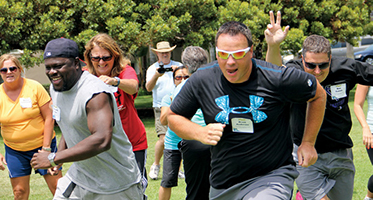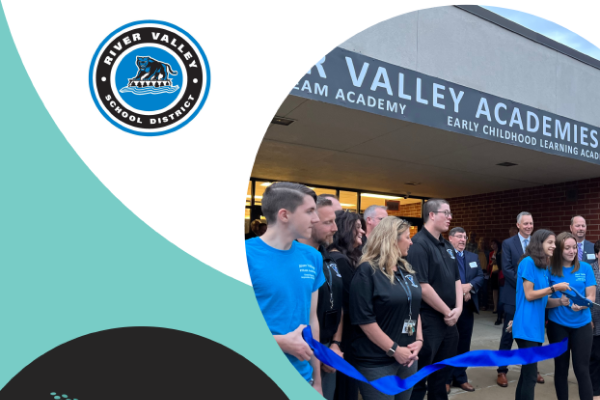Moving (Briskly Even) Beyond Tired Notions of P.E.
September 01, 2015

Industry Spotlight: Health and Wellness
“No one sport should predominate in a quality P.E. program or deserve marquee status,” says John Skretta, superintendent of Norris School District in Firth, Neb. “That’s a tired notion.
“The very nature of P.E. instruction has evolved,” he adds. “It’s about equipping kids with the developmental assets to draw upon for a lifetime.”
Skretta’s leadership in the schools just south of Lincoln has ensured that wellness, nutrition and phys-ed are given due consideration in budget decisions about curriculum, professional development and facilities. (Even master schedules have been adjusted to include two 10-minute activity breaks where students stretch during an activity like vocabulary study.) Physical education teachers are involved in the conversations, not muted on the sidelines.
The district’s holistic approach to student health required, Skretta explains, that “we re-imagine how P.E. works within a school system.” His success in doing so has drawn national recognition to the Norris schools.
Emerging Models
Just what is on the menu for sports in the standard, exploratory P.E. curriculum in his 2,300-student district? Fly fishing, archery, lacrosse, floor hockey and yoga (as part of a Mind and Body course) are offered, along with traditional team and other sports, such as swimming, track and tennis.
The old model of gym class often focused on a narrow range of team sports involving balls, nets, bats and mats. Sometimes programs catered more to talented athletes rather than ensuring all children participate in vigorous activity. Today phys-ed has branched out to include strength training, yoga, Pilates, Zumba, biking and hiking, thanks to new national and state standards that emphasize strength, endurance and flexibility, as well as wellness and nutrition.
While Norris School District benefits from enhanced attention under Skretta’s leadership, students in the Miami-Dade County Public Schools have the South Florida geography and climate in their favor.
Their wealth of physical education choices go well beyond traditional team and individual sports: swimming, kayaking, canoeing, snorkeling and paddle-boarding, as well as dance and fitness activities.
A high quality P.E. program is comprehensive; it includes dance, rhythm, cardiovascular activities, muscular strength, endurance and flexibility, explains Lisa Perry, a physical activity adviser for the Alliance for a Healthy Generation. “It is also more fitness-based.”
Those priorities and attributes serve as a partial checklist for evaluating and purchasing curriculum, training and equipment.
Districts facing budget challenges have helped support a program with grants or phased in changes. And a fitness-based model can be implemented without a significant capital outlay, says Kathy Chichester, CATCH national coordinator, “Many activities don’t require equipment,” she said. “There are skill builders, with lots of movement, tag-oriented games and skill-building games.”
Curriculum Standards
“You have to teach kids concepts, skills and understanding,” said Executive Director Kymm Ballard, whose organization, SPARK, helps districts identify the equipment to purchase and offers training and curriculum plans to implement the new standards.
“Districts should determine what kids should know and be able to do when they graduate,” says Ballard. “It’s a backwards plan — develop fitness goals and develop the physical activity goals and skills around that.”
Just as with other academic subjects, districts should focus on best practices and evidence-based programs to incorporate into the revamped physical education curriculum, which also should include age-appropriate outcomes and benchmarks for students.
If a district is moving to a fitness-based curriculum, the basic equipment can be minimal. Frisbees, noodles — even iPads or tablets — are what’s needed, explains Ballard.
“Medicine balls, kettle balls and body weights for resistance training are other common equipment,” Perry says.
In Miami-Dade, for example, students use resistance bands, jump ropes, balls, light body bars, treadmills and cross trainers in the district’s wellness center. The equipment is totally funded through grants, says Jayne D. Greenberg, district director of physical education, health literacy and JROTC.
Miami-Dade also uses technology, like Xbots, for “Dance Dance Revolution” and video to teach winter sports like snow-skiing.
And with more districts offering or adding fitness centers, administrators might want to consider purchasing a defibrillator, says Ward Hamilton, senior vice president of Zoll Medical Corp. “An EMS can’t get to you quickly enough. If you’re putting together a fitness center, you need to think about AEDs.”
Professional Development
None of this will work, however, without a concomitant effort in professional training and development, not only for the district’s physical education teachers but also for classroom teachers. To determine whether a curriculum is appropriate, even districts that don’t have a full-time phys-ed coordinator should take advantage of the expertise of their P.E. teachers, as well as the specialists at the state education agency.
Norris School District hired outside trainers for its P.E. teachers to help them gain hands-on skills and knowledge. The P.E. curriculum now familiarizes students and teachers with the seriousness of head injuries. Teacher training focuses on recognizing the symptoms of concussions in case they are not identified by the student and discusses how teachers must accommodate recovering students upon their return to class.
“A customized workshop from SPARK costs between $2,000-$10,000 for 40 teachers depending on their needs,” says Ballard. Schools can adapt SPARK as a place to start. You get assessments that are aligned with the national standards and you can edit the curriculum.”
The SPARK curriculum also provides adaptations that teachers can use to work with students with disabilities or who need accommodations. Ballard suggested using social media as a resource for teachers to talk about ideas and challenges.
Healthy Kids Challenge offers webinars, curriculum materials and onsite consulting programs and workshops, as well as free downloadable tip sheets to help districts. Through partnerships with organizations like SPARK, Healthy Kids Challenge focuses on training and education about wellness and nutrition to enhance newly invigorated phys-ed programs.
Return on Investment
“When a program can’t be implemented all at once, start with a pilot program at the youngest age possible,” says Carly Braxton, senior manager of SHAPE America. She urges districts to “collect data and show the success and impact of programming.”
Miami Dade, for example, has been relentless in making sure programs are having an impact. “Our programs are evidence-based,” says Greenberg. “We’re implementing state standards, working with the University of Miami School of Medicine. We collect data all year long.”
Programs use different measures of success, and districts will have to decide what measures they feel are appropriate.
“CATCH has improved educational outcomes, with academic performance and discipline, an increase in students choosing water, eating fruits and vegetables and a decrease in screen time, as well as an improvement in teacher self-confidence in teaching wellness,” says Duncan Van Dusen, executive director of the CATCH Global Foundation.
“Physical education is a critical component to educating the whole child, and healthy kids learn better,” says Perry. “You need to place as much emphasis on acquiring those skills as on academic skills.”
Author
Advertisement
Advertisement
Advertisement
Advertisement



